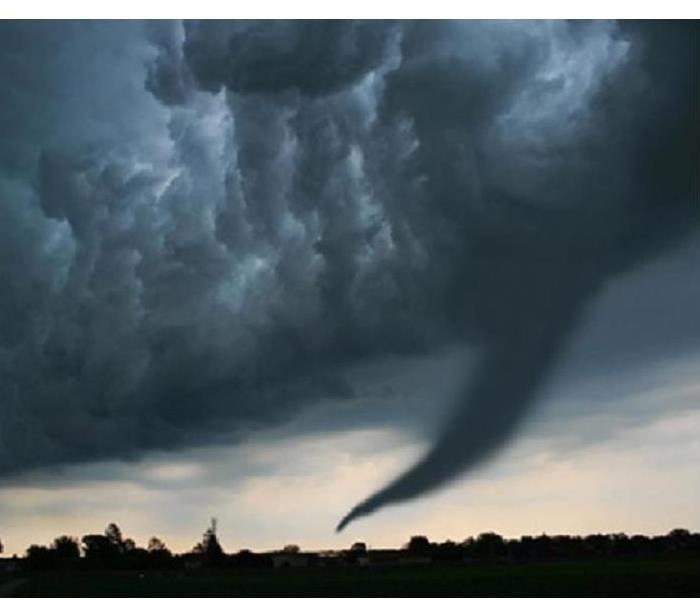Tornado Safety- What Should You Do?
3/11/2019 (Permalink)
Spring is just around the corner, the time of year when tornadoes are most common. However, powerful storms such as the ones which recently occurred in Alabama can happen at any time of the year. In fact, some experts say new parts of the country may see an increased threat of tornadoes in their areas.
TORNADO FACTS
- Tornadoes can happen anywhere, at any time of day but are most likely to occur between 3:00 and 9:00 p.m.
- The United States receives more than 1,200 tornadoes every year.
- The National Oceanic and Atmospheric Administration (NOAA) reports there were as many as 800 confirmed tornadoes in 2018.
- NOAA also reports the four deadliest states for tornadoes are Alabama, Missouri, Tennessee and Arkansas.
- Most tornadoes occur east of the Rocky Mountains.
- The area where we see the most tornadoes seems to be moving from the Plains states to the Southeast and Midwest, especially to states along the Mississippi River.
- KNOW YOUR COMMUNITY’S WARNING SYSTEM. There are different ways to notify people about tornadoes. Many communities use sirens intended for outdoor warning purposes.
- · IDENTIFY A SAFE PLACE IN YOUR HOME where you can gather – a basement, storm cellar or interior room on the lowest floor with no windows. In a high rise, pick a hallway in the center of the building as you may not have enough time to get to the lowest floor.
- SECURE ITEMS OUTSIDE that can be picked up by the wind.
- If you live in a mobile home, find a safe place in a nearby sturdy building. NO MOBILE HOME IS SAFE IN A TORNADO.
- KNOW THE WARNINGS. A tornado watch means a tornado is possible. A tornado warning means a tornado has been sighted or indicated by weather radar. IMMEDIATELY GO TO YOUR SAFE PLACE.
- WATCH FOR TORNADO DANGER SIGNS: dark, often greenish clouds, wall cloud, cloud of debris.
- BRING YOUR ANIMALS INDOORS and maintain direct control of them.
- IF YOU ARE OUTSIDE, look for the closest option to:
o Seek shelter in a basement, storm shelter or sturdy building.
o If you can’t walk to shelter, get into a vehicle and try to drive to a safe shelter.
o If strong winds and debris are occurring, pull over and put your vehicle in park. Keep your seat belt on and engine running. Protect your head by leaning down below the windows, covering your head with your hands and a blanket or jacket.
o Stay away from bridges and highway overpasses.
What should you do to be prepared for any weather emergency that threatens your community? Planning is the key. Being prepared is just a few short steps away:
1. GET A KIT. If you’ve ever fumbled to find a flashlight during a blackout, you know what it feels like to not be prepared. Get your emergency preparedness kit ready. You should include:
- Three-day supply of non-perishable food and water—one gallon per person, per day for drinking and hygiene purposes
- Battery-powered or hand crank radio (NOAA Weather Radio, if possible)
- Flashlight and extra batteries
- First aid kit, medications and medical items
- Copies of all important documents (proof of address, deed/lease to home, passports, birth certificates, insurance policies)
- Extra cash
2. MAKE A PLAN. Talk with household members about what you would do during emergencies. Plan what to do in case you are separated, and choose two places to meet - one right outside your home in case of a sudden emergency such as a fire, and another outside your neighborhood in case you cannot return home or are asked to evacuate.
- Choose a contact person from out of the area and make sure all household members have this person’s phone number and email address. It may be easier to call long distance or text if local phone lines are overloaded or out of service.
- Tell everyone in the household where emergency information and supplies are kept.
- Practice evacuating your home twice a year. Drive your planned evacuation route and plot alternate routes on a map in case main roads are impassable.
- Don’t forget your pets. If you must evacuate, make arrangements for your animals. Keep a phone list of “pet friendly” motels/hotels and animal shelters that are along your evacuation routes.
3. BE INFORMED. Know the risks where you live, work, learn and play.
- Arm yourself with information about what to do in case an emergency occurs. Remember that emergencies like fires and blackouts can happen anywhere, so everyone should be prepared for them.
- Find out how you would receive information from local officials in the event of an emergency.
- Learn first aid and CPR/AED so that you have the skills to respond in an emergency before help arrives, especially during a disaster when emergency responders may be delayed. A variety of online, in-classroom and blended (part online and part in the classroom) training courses are available at redcross.org/takeaclass.
In the event you sustain damage from high winds or water damage SERVPRO of Fenton/South Ballwin is available 24/7/365 to assist you. (636)527-5990




 24/7 Emergency Service
24/7 Emergency Service